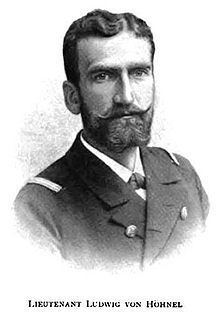Name Ludwig Hohnel | ||
 | ||
Ludwig Ritter von Höhnel (6 August 1857, Preßburg – 23 March 1942, Vienna) was an Austrian naval officer and explorer. He was trained at the naval academy in Fiume, then part of the Austrian empire. His brother was the naturalist Franz Xaver Rudolf von Höhnel (1852–1920).
Contents
Journey with Teleki 1887-1888
Höhnel was the second-in-command of Count Sámuel Teleki von Szek's expedition to Northern Kenya in 1887-1888. He and Teleki were the first Europeans to see Lake Turkana, which they named Lake Rudolf after the expedition's patron Crown Prince Rudolf of Austria, and also Lake Stefanie, named after Prince Rudolf's wife Princess Stéphanie of Belgium. Höhnel acted as the expeditions's cartographer, scientist, and diarist. Teleki and Höhnel made numerous observations on the climate, flora, and fauna of the territories visited and collected more than 400 ethnographical objects, most of them from Maasai and Kikuyu tribes. Their observations provided important contribution to ethnographical knowledge. The scientific results of the journey were published by Höhnel in several articles and in a book written in German and translated into Hungarian and English, entitled The Discovery of Lakes Rudolf and Stefanie (1892). The East African chameleon, known as Höhnel's Chameleon (Trioceros hoehnelii) was named after Ludwig von Höhnel.
Journey with Chanler 1892-1894
Between 1892 and 1894 Höhnel explored the territory in the vicinity of Mount Kilimanjaro with American magnate William Astor Chanler. They proceeded inland from the coast, mapping the north-eastern part of the Mount Kenya massif, the Guasso Nyiro River, the Lorian Swamp, the Tana River, Lake Rudolph and then Lake Stefanie. They were the first westerners in this region to come into contact with the Tigania, the Igembe Meru and the Rendille people. The expedition was eventually stranded in what is now the Meru North District of Kenya because of the death of all of its 165 pack animals (probably due to trypanosomiasis) and the desertion of many of the 200 porters. On 24 August 1893 Höhnel was gored by a rhinoceros and was forced to leave Chanler and return to Zanzibar and then Vienna, arriving in February 1894.
Later life
After recovering from his injuries, Höhnel became an officer on board the corvette SMS Donau, and traveled in 1897 to the Mediterranean and along the coast of West Africa south to Cameroon, then across the Atlantic to the Caribbean, and to New York and Newport, Rhode Island. During the trip, the ship's captain suffered a heart attack and Höhnel was made provisional commandant until June 1898. Also on this voyage he met the future US president Theodore Roosevelt, who was then in his words the 'much feared' police commissioner of New York. After this, Höhnel was assigned as officer of the deck to the central battery ship SMS Tegetthoff, whose executive officer was Commander Anton Haus, the future commander of the Austro-Hungarian Navy.

In 1899 Höhnel became Emperor Franz Joseph's aide-de-camp and later (1905–09) led an official Austro-Hungarian delegation to Emperor Menelik II of Ethiopia. He also commanded the Austro-Hungarian cruiser SMS Panther in a voyage to Australia and Polynesia. Höhnel was instrumental in introducing the chamois into New Zealand, negotiating the acquisition in 1905 of six does and two bucks from Neuberg in Austria. They finally arrived in New Zealand on board the SMS Turakino in 1907. He was the commanding officer of the armored cruiser SMS Sankt Georg and the commander of the navy yard in Pula.
In February 1907 he submitted a formal request to the navy for permission to marry Valeska von Ostéren (1870-1947) (permission was required as per Austrian naval regulations). However, permission was denied, because it was discovered that Valeska's brother had published an anti-Jesuit novel in 1906 which had offended the powerful Archduke Franz Ferdinand. Höhnel was eventually forced to choose between his marriage and his naval career. He married Valeska in August 1909 and subsequently resigned in the rank of captain. In 1912 he was promoted to rear admiral, probably in recognition of his duties as aide-de-camp to the emperor.
Post-naval career
Höhnel wrote an autobiography centered on the turbulent years preceding the fall of the Austro-Hungarian monarchy, providing insights into African exploration, the Austro-Hungarian Navy, and prominent personalities of the Habsburg court, including Admiral Hermann von Spaun, Admiral Maximilian Daublebsky von Sterneck, and Rudolf Montecuccoli. The complete manuscript remained in the possession of the family of William Astor Chanler for many decades and was finally published in 2000.
Höhnel later wrote a 56-page account of his service as aide-de-camp to Emperor Francis Joseph, which was never published.
He died in Vienna in March 1942.
